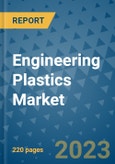The global production of engineering plastics has exceeded 25 million tons annually, with demand accounting for over 10% of the total global plastics demand. Engineering plastics offer superior performance compared to standard plastics, making them an ideal choice for tough engineering applications. Their lightweight nature and ease of manufacturing in various shapes have positioned them as preferred substitutes for traditional materials such as metals and wood.
According to the analyst's upcoming study on the global engineering plastics market, engineering plastics are gradually replacing popular commodity plastics like polyethylene, polypropylene, polystyrene, and polyvinyl chloride (PVC). In 2018, China led the Asia Pacific market, driven by robust demand from the automotive and consumer electronics industries.
Automotive Industry Leads the Adoption of Engineering Plastics
End users in various industries, including automotive, building and construction, electronics and electrical, consumer goods, and packaging, have a high demand for engineering plastics. These materials offer excellent chemical and heat resistance, fire retardancy, impact resistance, and mechanical strength. Among the consumer industries, the automotive sector witnessed the highest consumption of engineering plastics in 2018. This is attributed to the increasing trend of fuel-efficient, lightweight automobiles that align with the global shift towards e-mobility.
Engineering plastics have been replacing conventional glass and metal materials in numerous automotive exterior and interior applications. The diminishing reserves of fossil fuels, rising fuel prices, and stricter fuel-efficiency regulations worldwide further drive the demand for engineering plastics in the global market. Additionally, the electronics and electrical equipment industry is adopting engineering plastics due to their durability, impact resistance, heat resistance, electrical insulation properties, and design flexibility within complex electronic structures.
Growing Demand for Innovative Building Materials Supports Engineering Plastics Sales
The expanding building and construction industry and ongoing infrastructural developments provide a favorable environment for the growth of the engineering plastics market. This trend is particularly prominent in developed regions and is expected to continue with the recovery of the construction industry in recent years. Innovative building materials, including engineering plastics such as polyamide, polycarbonate, and acrylonitrile butadiene styrene (ABS), are in high demand for non-residential applications such as roofing systems, window glazing, and skylights. The increasing need for durable and lightweight materials further propels the prospects of engineering plastics.
In the medical devices sector, there is a shift away from traditional materials like metal and glass, driving attention towards flexible engineering plastics with competitive pricing. However, the slow rate of recycling remains a long-standing challenge for the industry. Efforts are underway to develop new recycling models and achieve a circular economy in the engineering plastics space. Additionally, advanced composites are emerging as a viable alternative to engineering plastics.
Key Companies Focus on Capacity Expansion and M&A
Leading players in the global engineering plastics market include BASF, Celanese, Covestro, SABIC, Domo, and DSM. These companies are expanding their production capacities to meet the growing demand from key consumer industries such as automotive, building and construction, and electronics and electrical. Product innovations remain a preferred growth strategy in a competitive market. Strategic mergers and acquisitions, as well as joint ventures, are profitable moves for companies seeking an expanded regional and global footprint. BASF SE's acquisition of Solvay's polyamide business in 2020 and DSM's acquisition of SRF's engineering plastics division in 2019 are examples of such strategic moves. Companies are also prioritizing digitalization in production and logistics to improve efficiency and minimize environmental impact.
Table of Contents
Companies Mentioned (Partial List)
A selection of companies mentioned in this report includes, but is not limited to:
- BASF SE
- SABIC
- INEOS
- SCG
- BASF SE
- Covestro AG
- Celanese
- Avient Corporation
- Evonik Industries AG
- Solvay S.A.
- DSM
- Borealis AG
- LyondellBasell Industries N.V.
- Lanxess
- LG Chem
- PolyOne
Methodology

LOADING...








